Sir John Monash, Personal Files Book 2, 23 February - 31 March 1915, Part 1
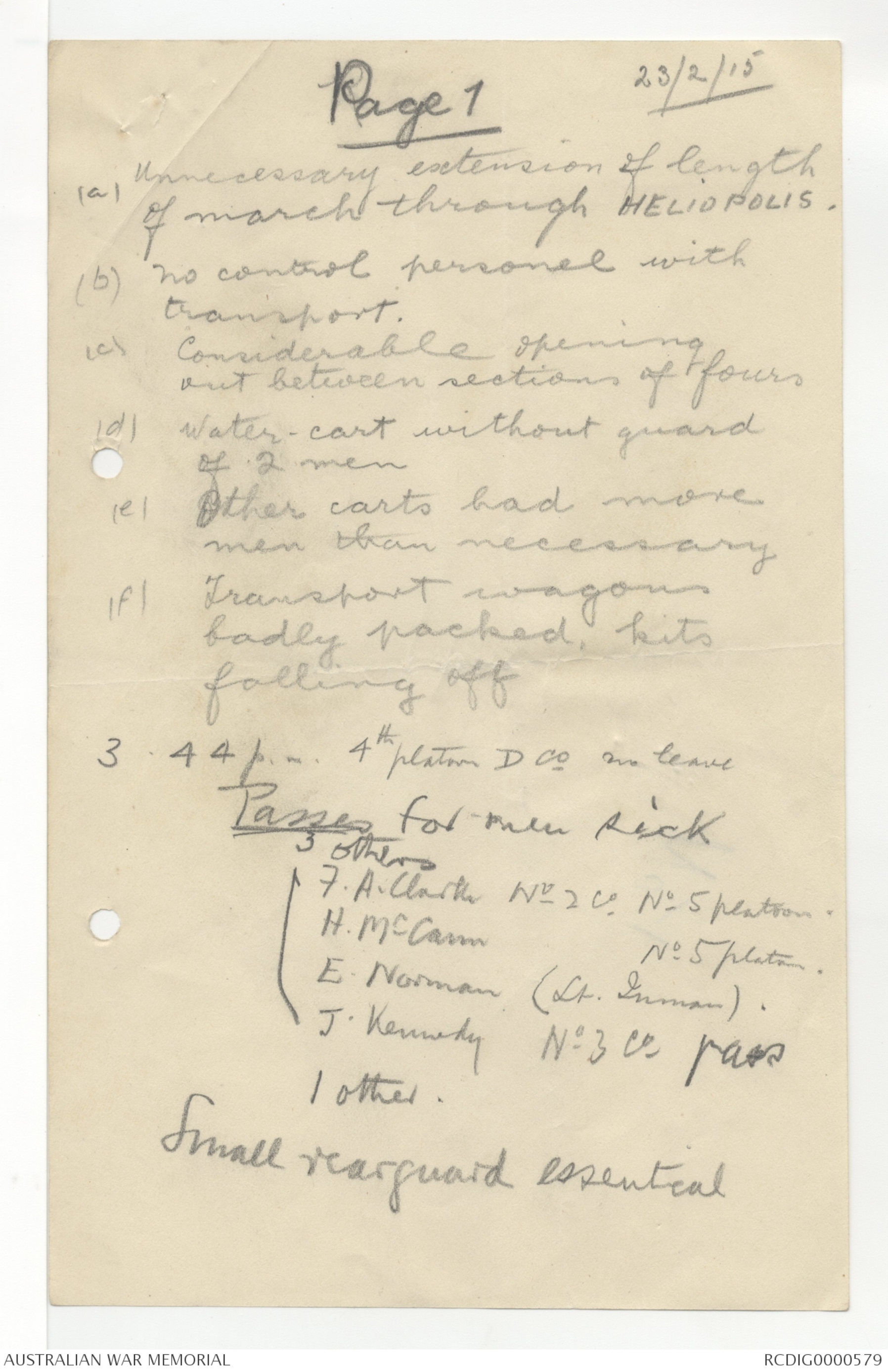
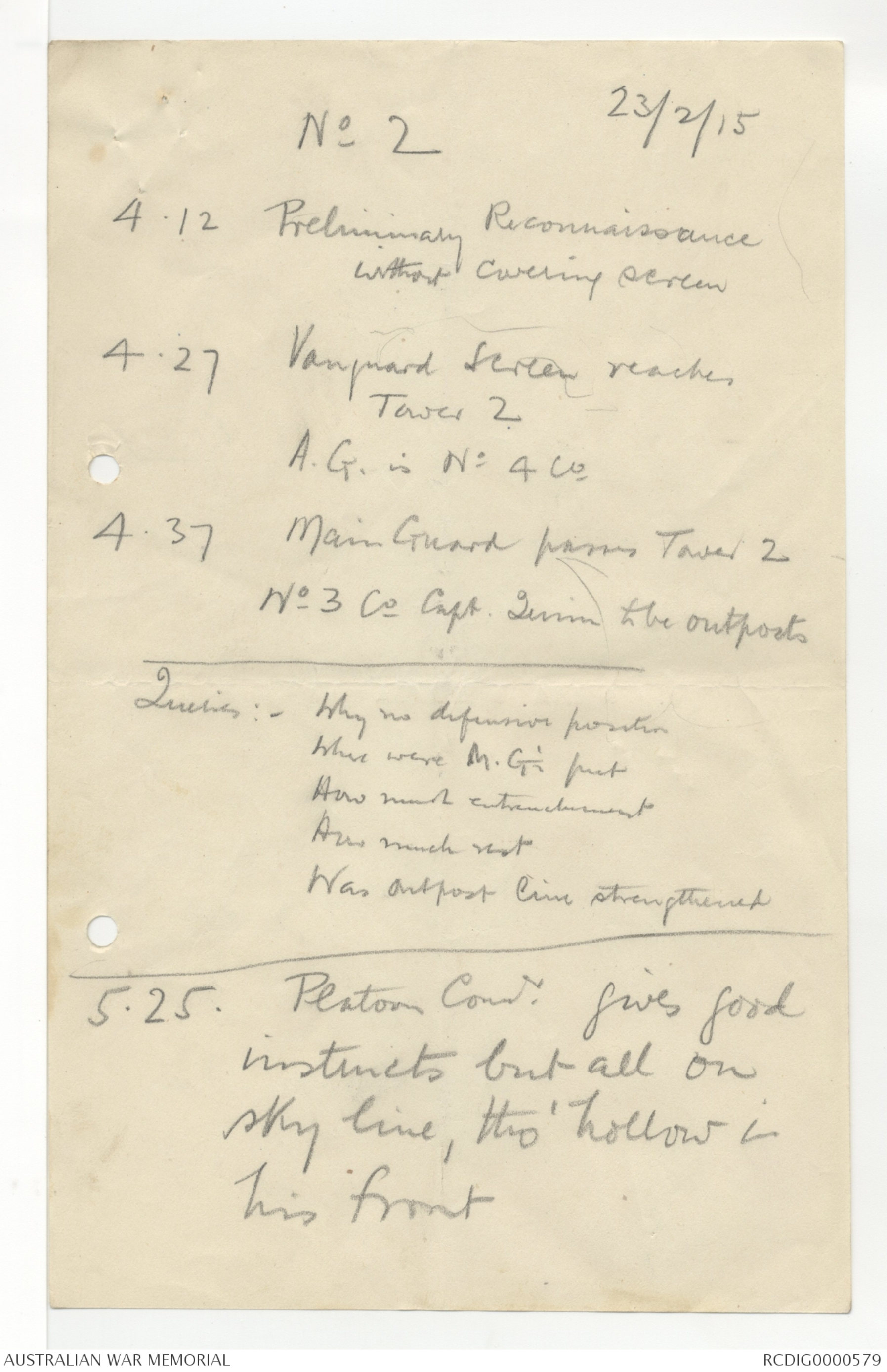
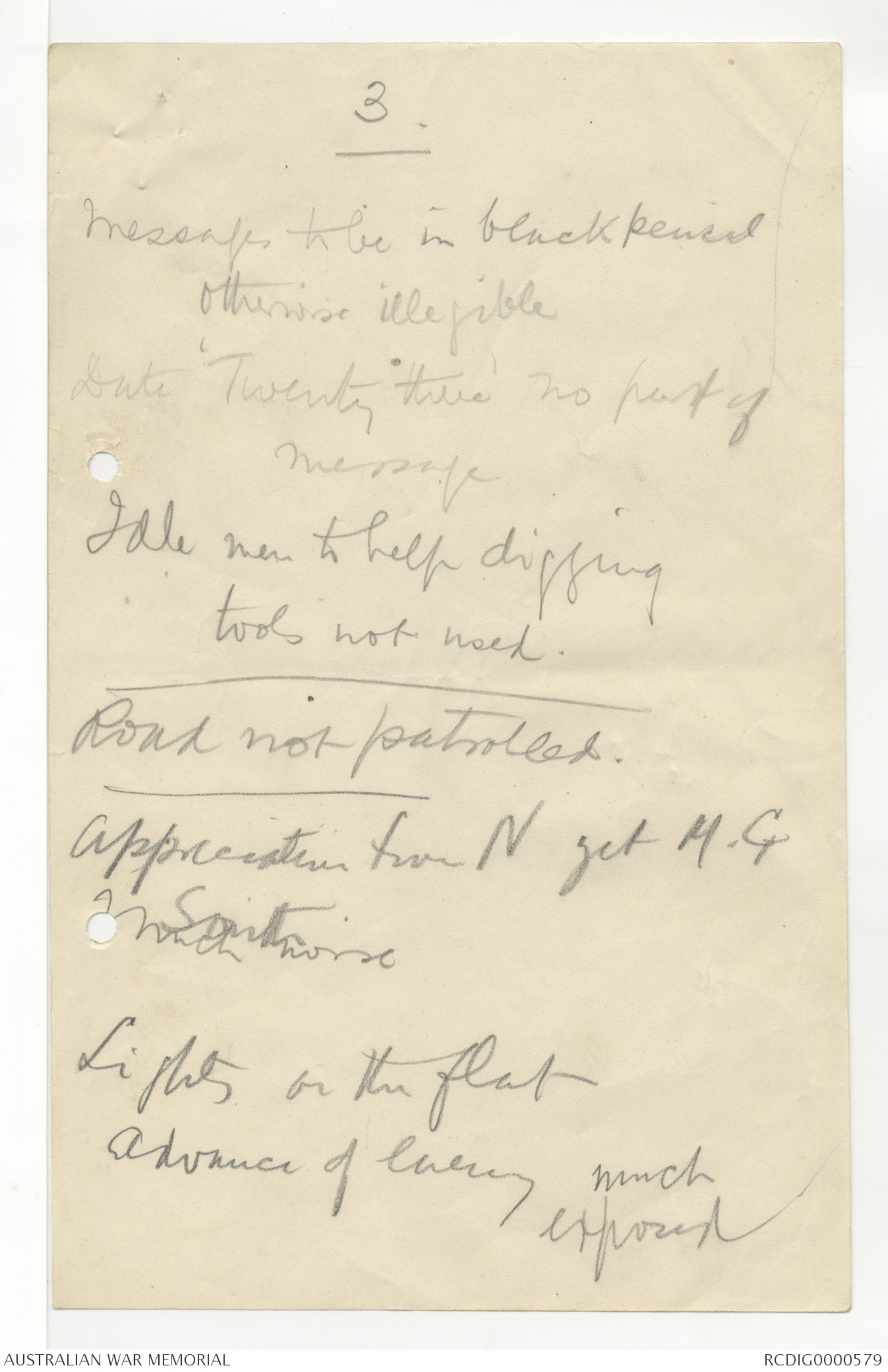
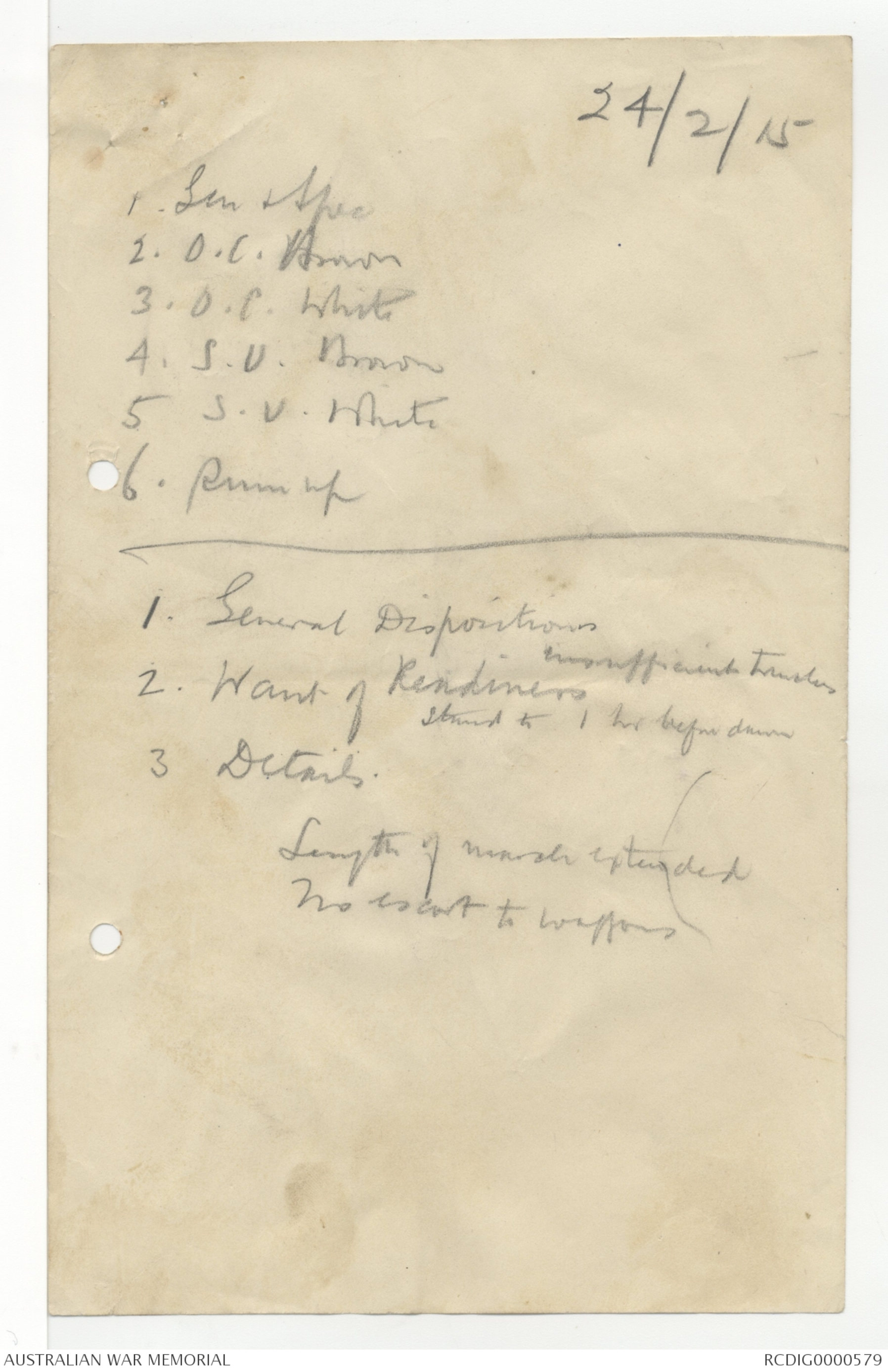
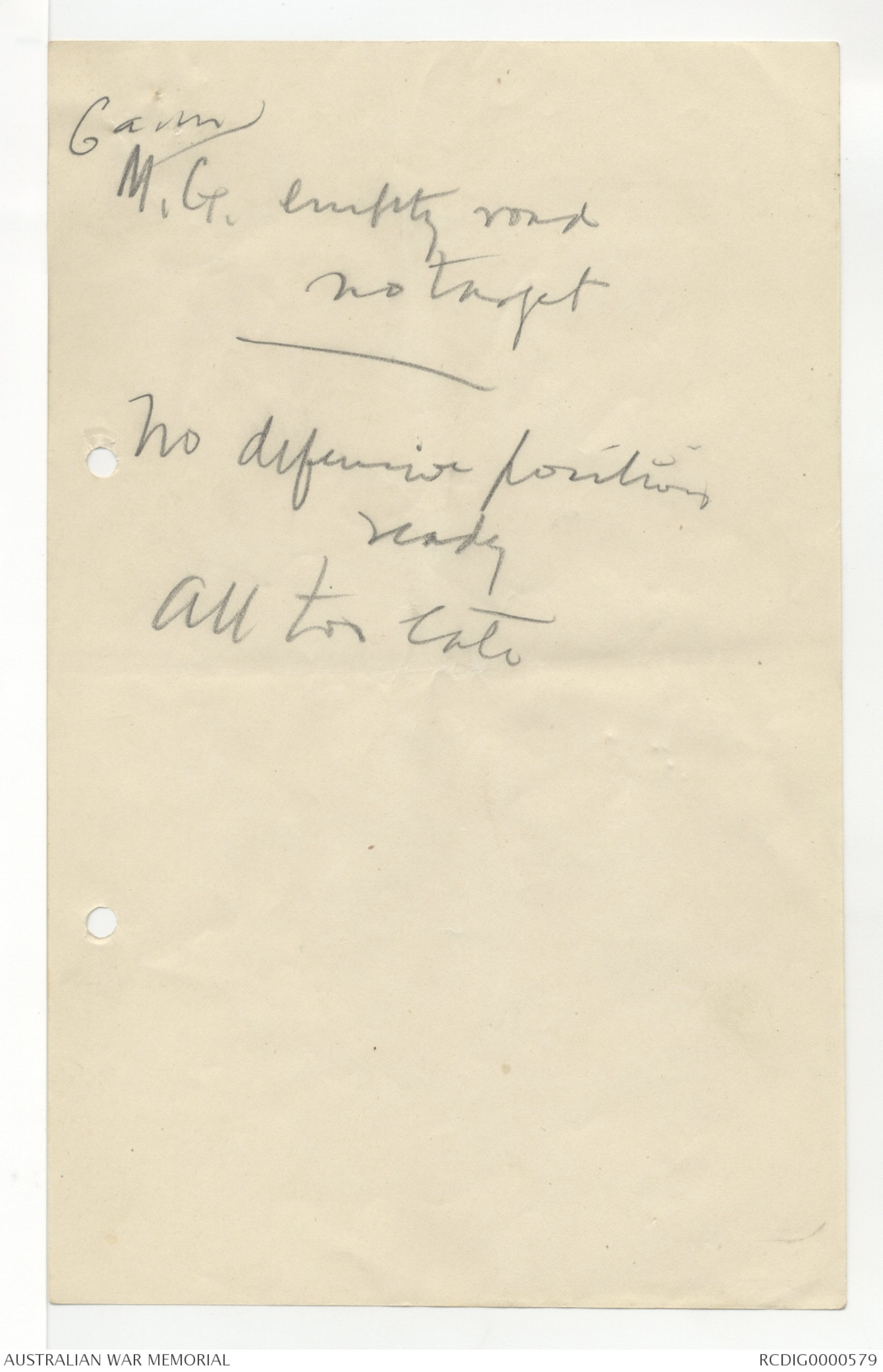
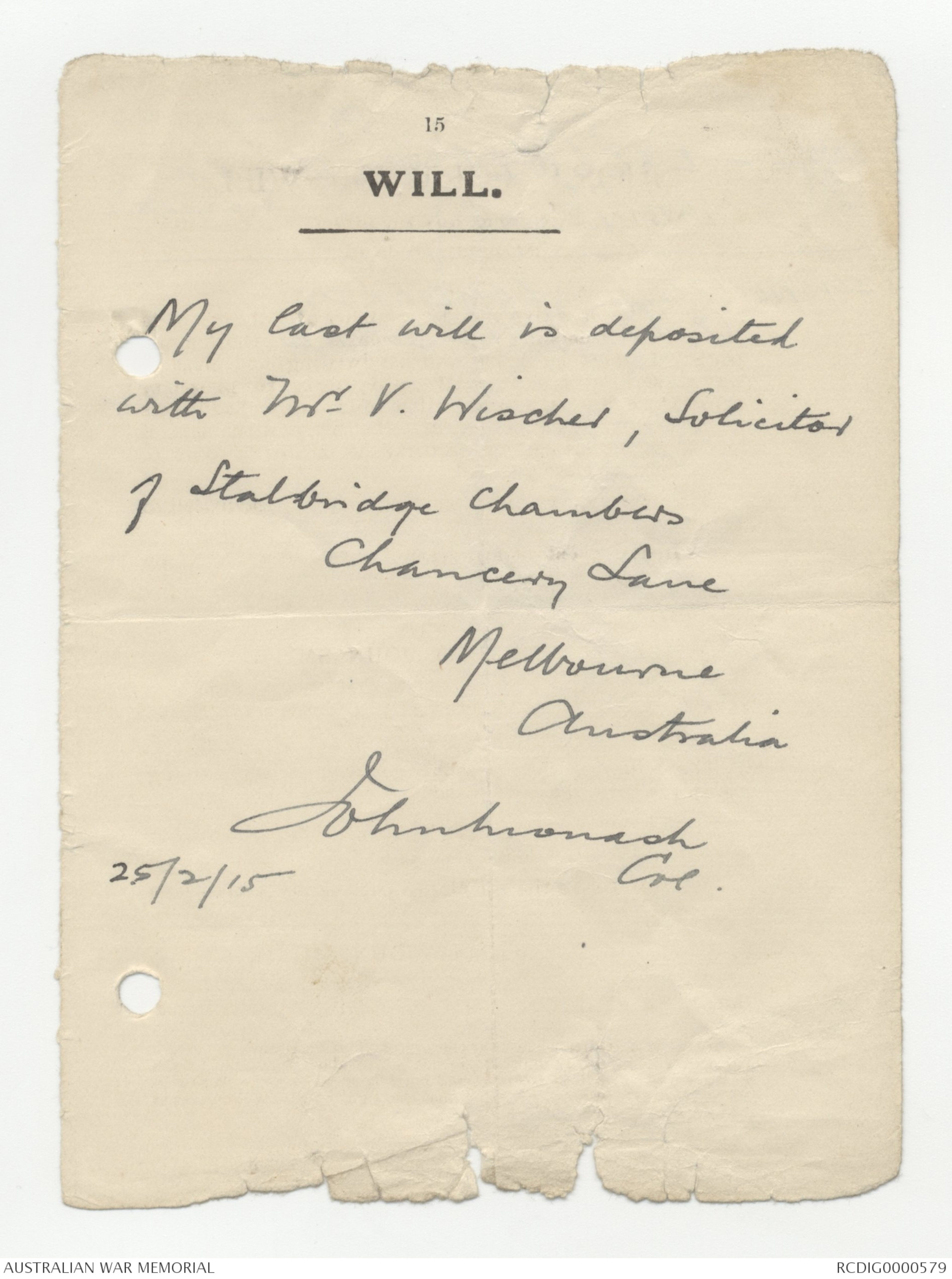
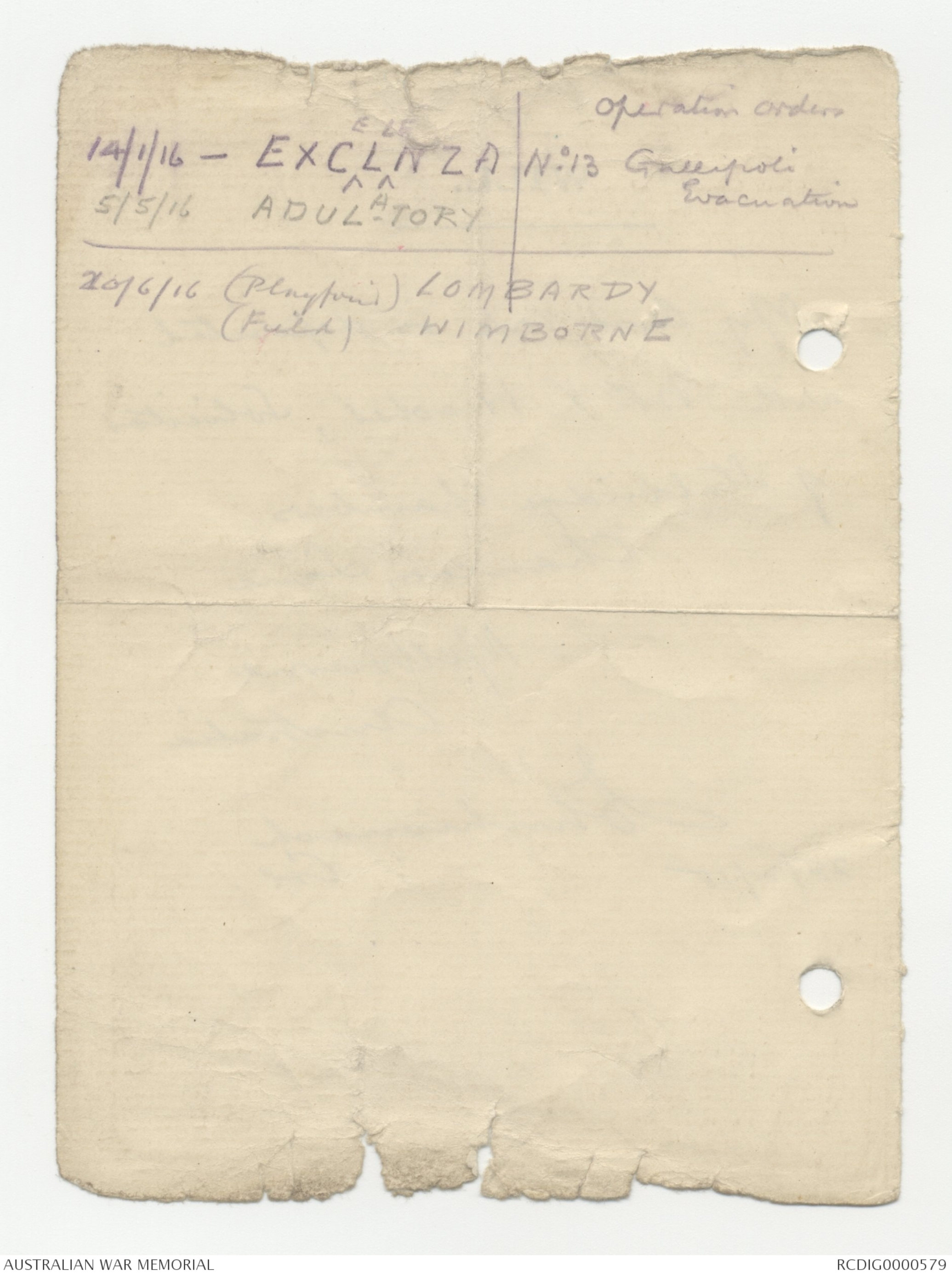
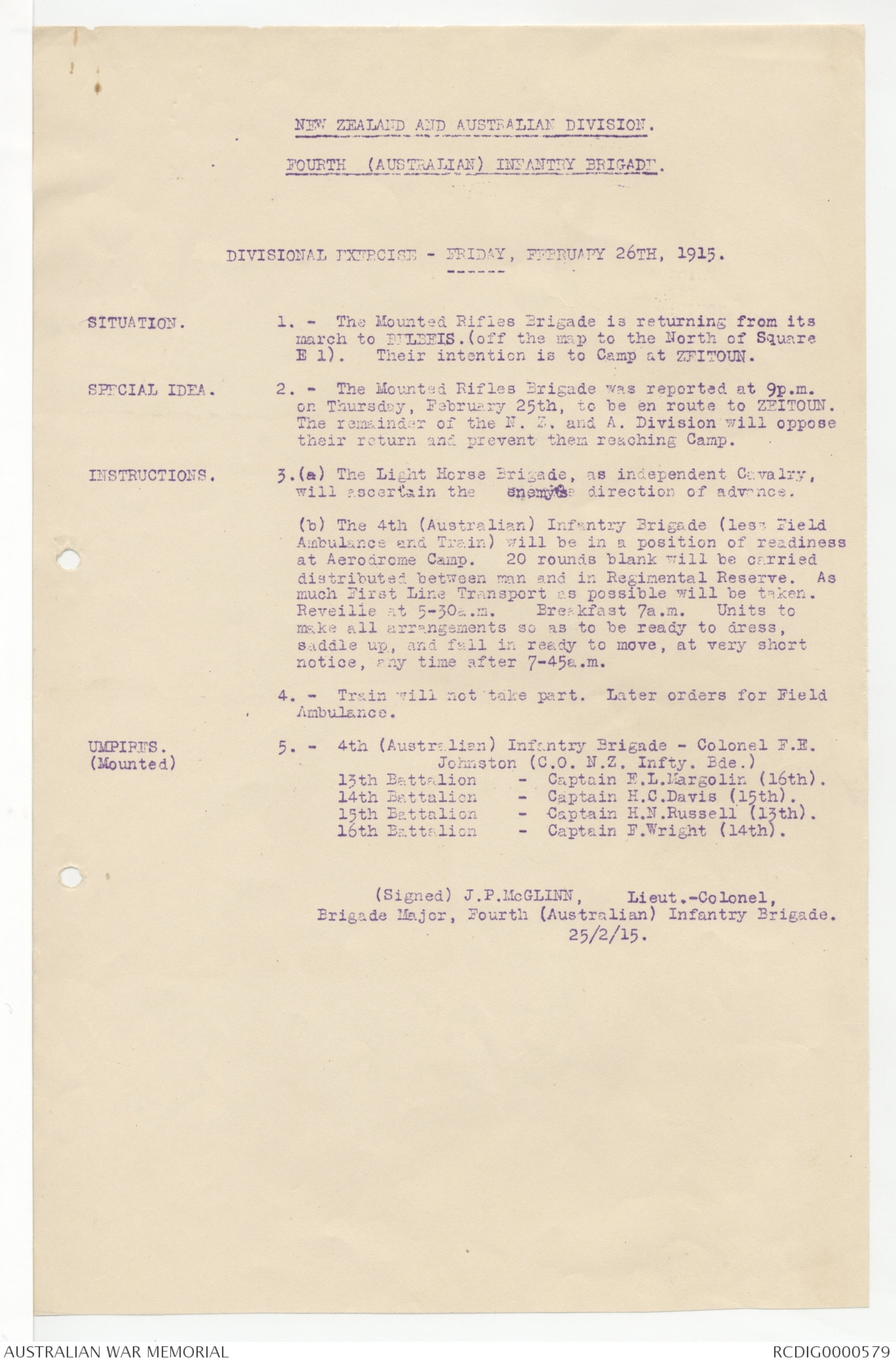
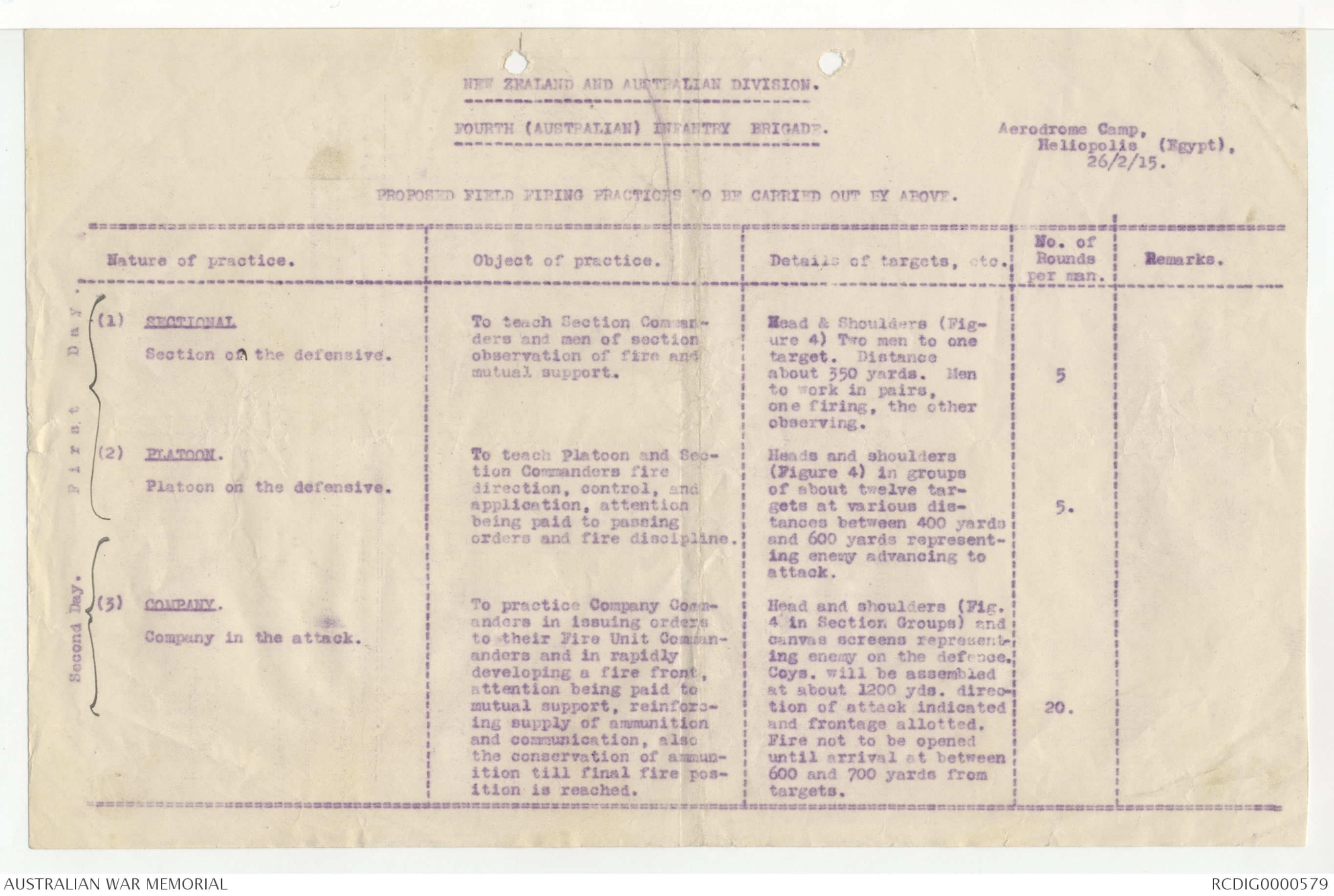
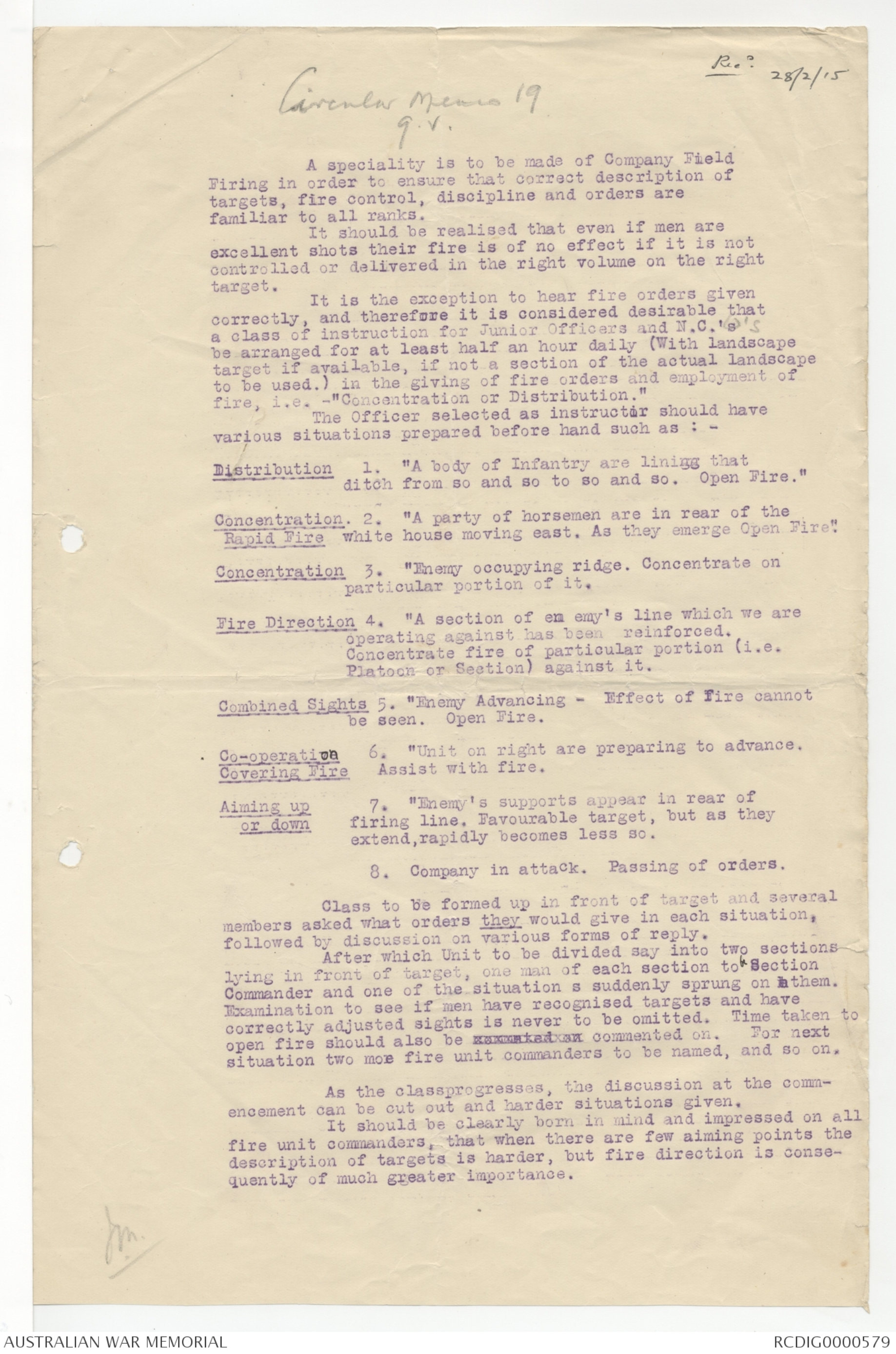
23/2/15
Page 1
(a) Unnecessary extension of length
of march through HELIOPOLIS.
(b) No control personel with
transport.
(c) Considerable opening
out between sections of fours
(d) Water-cart without guard
of 2 men
(e) Other carts had more
men than necessary
(f) Transport wagons
badly packed, kits
falling off
3 . 44 p.m. 4th platoon D Co no leave
Passes for men sick
3 others
F. A. Clark No 2 Co No 5 platoon.
H. McCann No 5 platoon.
E. Norman (Lt. Inman).
J. Kennedy No 3 Co pass
1 other.
Small rearguard essential
23/2/15
No 2
4.12 Preliminary Reconnaissance
without covering screen
4.27 Vanguard Screen reaches
Tower 2
A.G. is No 4 Co
4.37 Main Guard passes Tower 2
No 3 Co Capt. Quinn to be outposts
------------------
Questions:- Why no defensive position
Where were M. G's put
How much entrenchment
How much rest
Was outpost line strengthened
--------------------
5.25. Platoon Commr. gives good
instincts but all on
sky line, tho' hollow in
his front
3.
messages to be in black pencil
otherwise illegible
Date 'Twenty three' no part of
message
Idle men to help digging
tools not used.
__________________________________
Road not patrolled.
___________________________________
Appreciation from N yet M.G
Smith
much worse
Lights on the flat
Advance of enemy much
exposed
24/2/15
1. Gen Spec
2. O.C. Brown
3. O.C. White
4. S.V. Brown
5. S.V. White
6. Run up
_________________________
1. General Dispositions
- insufficient trenches
2. Want of Readiness
stand to 1 hr before dawn
3 Details
Length of march extended
no escort to waggons
6 a m
M.G. empty road
no target
_________________
No defensive positions
ready
all too late
15
WILL.
__________________
My last will is deposited
with Mr. V. Wischer, Solicitor
of Stalbridge Chambers
Chancery Lane
Melbourne
Australia
John Monash
Col.
25/2/15
Operation orders
14/1/16 - EXCELLENZA No 13 Gallipoli
Evacuation
5/5/16 ADULATORY
__________________________________________
20/6/16 (Playpoint) LOMBARDY
(Field) WIMBORNE
NEW ZEALAND AND AUSTRALIAN DIVISION.
FOURTH (AUSTRALIAN) INFANTRY BRIGADE.
DIVISIONAL EXERCISE - FRIDAY, FEBRUARY 26TH, 1915.
---------
SITUATION. 1. - The Mounted Rifles Brigade is returning from its
march to BELBEIS. (off the map to the North of Square
E 1). Their intention is to Camp at ZEITOUN.
SPECIAL IDEA. 2. - The Mounted Rifles Brigade was reported at 9p.m.
on Thursday, February 25th, to be en route to ZEITOUN.
The remainder of the N. Z. and A. Division will oppose
their return and prevent them reaching Camp.
INSTRUCTIONS. 3. (a) The Light Horse Brigade, as independent Cavalry,
will ascertain the enemy's direction of advance.
(b) The 4th (Australian) Infantry Brigade (less Field
Ambulance and Train) will be in a position of readiness
at Aerodrome Camp. 20 rounds blank will be carried
distributed between man and in Regimental Reserve. As
much First Line Transport as possible will be taken.
Reveille at 5-30a.m. Breakfast 7a.m. Units to
make all arrangements so as to be ready to dress,
saddle up, and fall in ready to move, at very short
notice, any time after 7-45a.m.
4. - Train will not take part. Later orders for Field
Ambulance.
UMPIRES. 5. - 4th (Australian) Infantry Brigade - Colonel F.E.
(Mounted) Johnston (C.O. N.Z. Infty. Bde.)
13th Battalion - Captain E.L. Margolin (16th).
14th Battalion - Captain H.C. Davis (15th).
15th Battalion - Captain H.N. Russell (13th).
16th Battalion - Captain F. Wright (14th).
(Signed) J.P. McGLINN, Lieut.-Colonel,
Brigade Major, Fourth (Australian) Infantry Brigade.
25/2/15.
NEW ZEALAND AND AUSTRALIAN DIVISION.
FOURTH (AUSTRALIAN) INFANTRY BRIGADE.
Aerodrome Camp,
Heliopolis (Egypt),
26/2/15.
PROPOSED FIELD FIRING PRACTICES TO BE CARRIED OUT BY ABOVE
| Nature of practice. | Object of practice. | Details of targets, etc. |
No. of Rounds per man. |
Remarks. |
|
First Day (1) SECTIONAL Section on the defensive. |
To teach Section Commanders and men of section observation of fire and mutual support. |
Head and Shoulders (Figure 4) Two men to one target. Distance about 350 yards. Men to work in pairs, one firing, the other observing. |
5 | |
|
(2) PLATOON. Platoon on the defensive. |
To teach Platoon and Section Commanders fire direction, control, and application, attention being paid to passing orders and fire discipline. |
Heads and shoulders (Figure 4) in groups of about twelve tar- gets at various distances between 400 yards and 600 yards representing enemy advancing to attack. |
5. | |
|
Second Day (3) COMPANY. Company in the attack. |
To practice Company Commanders in issuing orders to their Fire Unit Commanders and in rapidly developing a fire front, attention being paid to mutual support, reinforcing supply of ammunition and communication, also the conservation of ammunition till final fire position is reached.
|
Head and shoulders (Fig. 4 in Section Groups} and canvas screens represent- ing enemy on the defence. Coys. will be assembled at about 1200 yds. direction of attack indicated and frontage allotted. Fire not to be opened until arrival at between 600 and 700 yards from targets. |
20. |
Recd
28/2/15
Circular Memo 19
9.v.
A speciality is to be made of Company Field
Firing in order to ensure that correct description of
targets, fire control, discipline and orders are
familiar to all ranks.
It should be realised that even if men are
excellent shots their fire is of no effect if it is not
controlled or delivered in the right volume on the right
target.
It is the exception to hear fire orders given
correctly, and therefore it is considered desirable that
a class of instruction for Junior Officers and N.C.O 's
be arranged for at least half an hour daily (With landscape
target if available, if not a section of the actual landscape
to be used.) in the giving of fire orders and employment of
fire, i.e. - "Concentration or Distribution."
The Officer selected as instructor should have
various situations prepared before hand such as :-
Distribution 1. "A body of Infantry are lining that
ditch from so and so to so and so. Open Fire."
Concentration. 2. "A party of horsemen are in rear of the
Rapid Fire white house moving east. As they emerge Open Fire"
Concentration 3. "Enemy occupying ridge. Concentrate on
particular portion of it.
Fire Direction 4. "A section of en emy's line which we are
operating against has been reinforced.
Concentrate fire of particular portion (i.e.
Platoon or Section) against it.
Combined Sights 5. "Enemy Advancing - Effect of fire cannot
be seen. Open Fire.
Co-operation 6. "Unit on right are preparing to advance.
Covering Fire Assist with fire.
Aiming up 7. "Enemy’s supports appear in rear of
or down firing line. Favourable target, but as they
extend, rapidly becomes less so.
8. Company in attack. Passing of orders.
Class to be formed up in front of target and several
members asked what orders they would give in each situation,
followed by discussion on various forms of reply.
After which Unit to be divided say into two sections
lying in front of target, one man of each section to be Section
Commander and one of the situation s suddenly sprung on h them.
Examination to see if men have recognised targets and have
correctly adjusted sights is never to be omitted. Time taken to
open fire should also be commnted an commented on. For next
situation two more fire unit commanders to be named, and so on,
As the class progresses, the discussion at the commencement
can be cut out and harder situations given.
It should be clearly born in mind and impressed on all
fire unit commanders, that when there are few aiming points the
description of targets is harder, but fire direction is consequently
of much greater importance.
J.M.
 Jacqueline Kennedy
Jacqueline KennedyThis transcription item is now locked to you for editing. To release the lock either Save your changes or Cancel.
This lock will be automatically released after 60 minutes of inactivity.